Page Last Updated:
Tuesday, 07 June 2016 11:27 EDT, © 2011, 2012, 2013, 2014, 2016
PROJECT: IW Ontology 2
Dr. Dean S. Hartley III
| Project Metadata |
Keywords |
|
Label |
Name |
Other |
Year |
DurationYrs |
|
Client |
TRAC |
US Army |
|
|
|
Dates |
|
|
2012 |
1 |
|
Employer |
Hartley
Consulting |
|
|
|
|
Partner |
BMA |
|
|
|
|
Pubs |
"Engineering
an Irregular Warfare (IW) Model," in Hawaii University
International Conferences (HUIC) Proceedings, June 2014 |
author |
2014 |
|
|
Pubs |
"Chapter 5:
DIME/PMESII Models," in Conflict and Complexity, edited
by Philip Vos Fellman, Yaneer Bar-Yam and Ali A. Minai, 2015 |
author |
2015 |
|
|
Pubs |
Irregular Warfare (IW) Ontology Final Report |
lead author |
2013 |
|
|
Pubs |
"Psychological Profiling of World Leaders," in OR/MS Today,
Vol 41, No 6, December 2014 |
lead author |
2014 |
|
|
Pubs |
"Ontologies
Support M&S Analysis in the IW Domain," in Phalanx, Vol
47, No 2, June 2014 |
lead author |
2014 |
|
|
Team |
Deborah
Duong, Kenneth O. Jobson, Lee W. Lacy, Paul W. Works |
|
|
Configuration management |
|
Consequence Management |
|
Data collection |
|
Data Verification & Validation |
|
Database design |
|
DIME/PMESII Modeling |
|
Documentation standards |
|
Geopolitical analysis |
|
Global War on Terrorism (GWOT) |
|
Human factors |
|
Human, Social, Cultural Behavior (HSCB) Modeling |
|
Impact analysis |
|
Independent Verification & Validation (IV&V) |
|
Information storage and retrieval |
|
Irregular Warfare (IW) |
|
Knowledge Management (KM) |
|
Metadata |
|
Model/System integration |
|
Modeling, Simulation & Gaming (MSG) |
|
Network analyses |
|
Ontologies |
|
Operations Other Than War (OOTW) |
|
Software issues |
|
Software reuse |
|
Stability Operations (SASO, SSTR) |
|
Verification, Validation & Accreditation (VV&A) |
|
Warfare modeling |
|
Challenge:
Create a total ontology of the elements needed for modeling Irregular Warfare (IW)
and create the connections between this ontology and an extension of the
military's Lines of Effort (LOE) concept to all of the principal actors in an IW.
Background:
Many IW analysis tasks require tools to describe complex operational
environments (OE). TRAC is developing ontologies to support consistent
representations of the state of the OE and describe actors performing
actions that affect the OE. Ontologies
use controlled vocabularies to help
formalize
the relationships between concepts,
simplify
information interchange, provide
a catalog of variables to use as a starting point, provide
common terms to communicate about concepts, and
guide
efforts to acquire, develop and use data. The
TRAC ontologies include Goal-Task-Owner (GTO) sets to describe
the tasks performed by organizations to achieve goals and
provide
Use Cases for the factions that represent various perspectives in IW
situations. The initiative is derived from the TRAC IW
Metric Ontology project and the Total IW
Ontology independent research and development project. The first project developed the conceptual model shown
in the figure below.
|
The central organizational principle for the development of the IW
Metric Ontology is provided by the high-level context diagram to the right. The
Operational Environment that includes everything relevant to
irregular warfare is divided into three parts: Actors, Actions, and
the Environment. Actors are human and natural entities that cause
things to happen, thereby changing things.
Actions are the interventions, events, and ongoing processes that
are performed by actors and which directly cause changes.
The Environment represents the rest of entities in the
Operational Environment.
Actors perform Actions, which affect the Operational Environment
(OE). The state of OE, including any changes, is described by State
Variables. Actors perceive the OE by means of the State Variables.
State Variables include both numeric variables (true metrics) and
categorical variables (e.g., type of government). IW Metrics
are defined to be these State Variables and provide the content of
the IW Metric Ontology. |
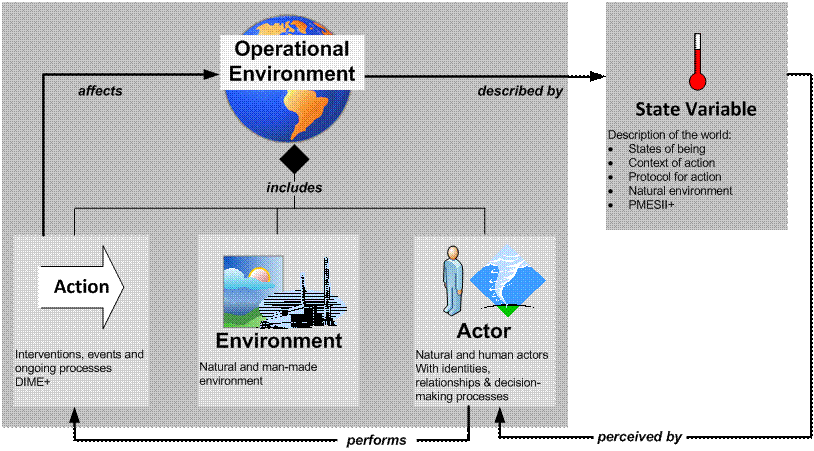 |
The initial effort (the IW
Metric Ontology project) focused on creating a metric ontology, using the
actor, action, and environment elements as reference data. The second effort
(the Total IW
Ontology project)
focused on completing the actor, action, and environment ontologies, with the
possibility of creating additional metric classes in the process. This
effort checked the consistency of the four ontology structures and
concentrated on creating additional semantic ontologies within them,
principally the GTO sets.
The entire ontology consists of several ontologies, divided
into three categories. The first set of ontologies consists of those with
structures defined by the Operational Environment. The second set consists
of ontologies with structures defined by the ontology contents. These
first two sets are situation-independent, that is the contents describe a
generic irregular warfare situation. The third set consists of ontologies
with structures that are situation-independent, but which have
situation-dependent contents.
Ontology Structures Defined by the Operational Environment:
The four main ontologies are the metric ontology, the actor ontology, the
action ontology, and the environment ontology. Each ontology has
categories and subcategories. There are eight metric categories, five
actor categories, seven action categories, and four environment categories.
Each element in the actor, action and environment ontologies is connected to one
or more metric classes, which describe the element.
1. Metric Ontology
| The figure to the
right provides a list of the categories and subcategories of the
metric ontology. There are 749 metric classes in the metric
ontology. A full list of the metric classes can be downloaded
here. |
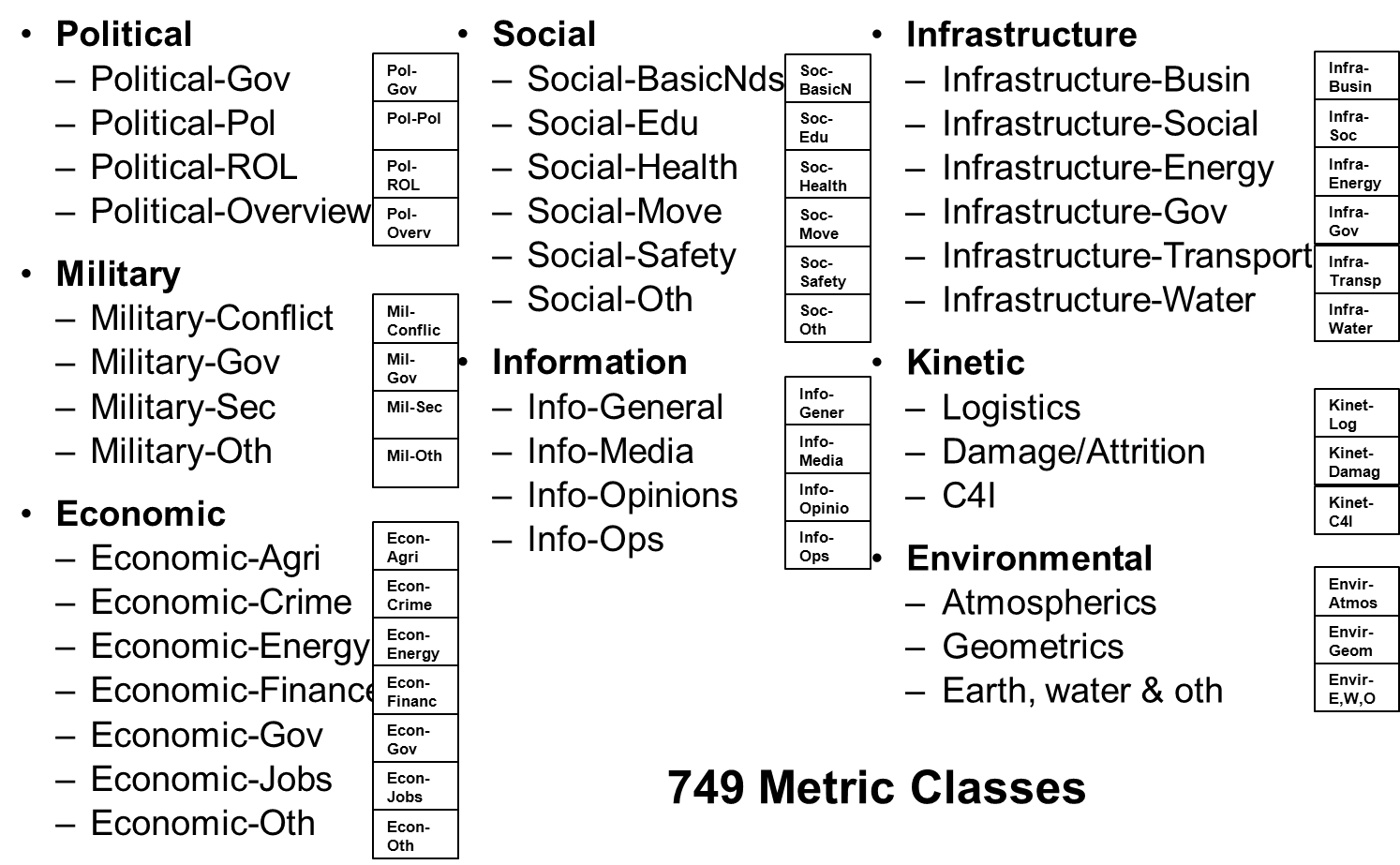 |
2. Actor Ontology
|
The figure to the right provides a list of the categories and
subcategories of the actor ontology. There are 102 actor classes in
the actor ontology. A full list of the actor classes can be
downloaded here. |
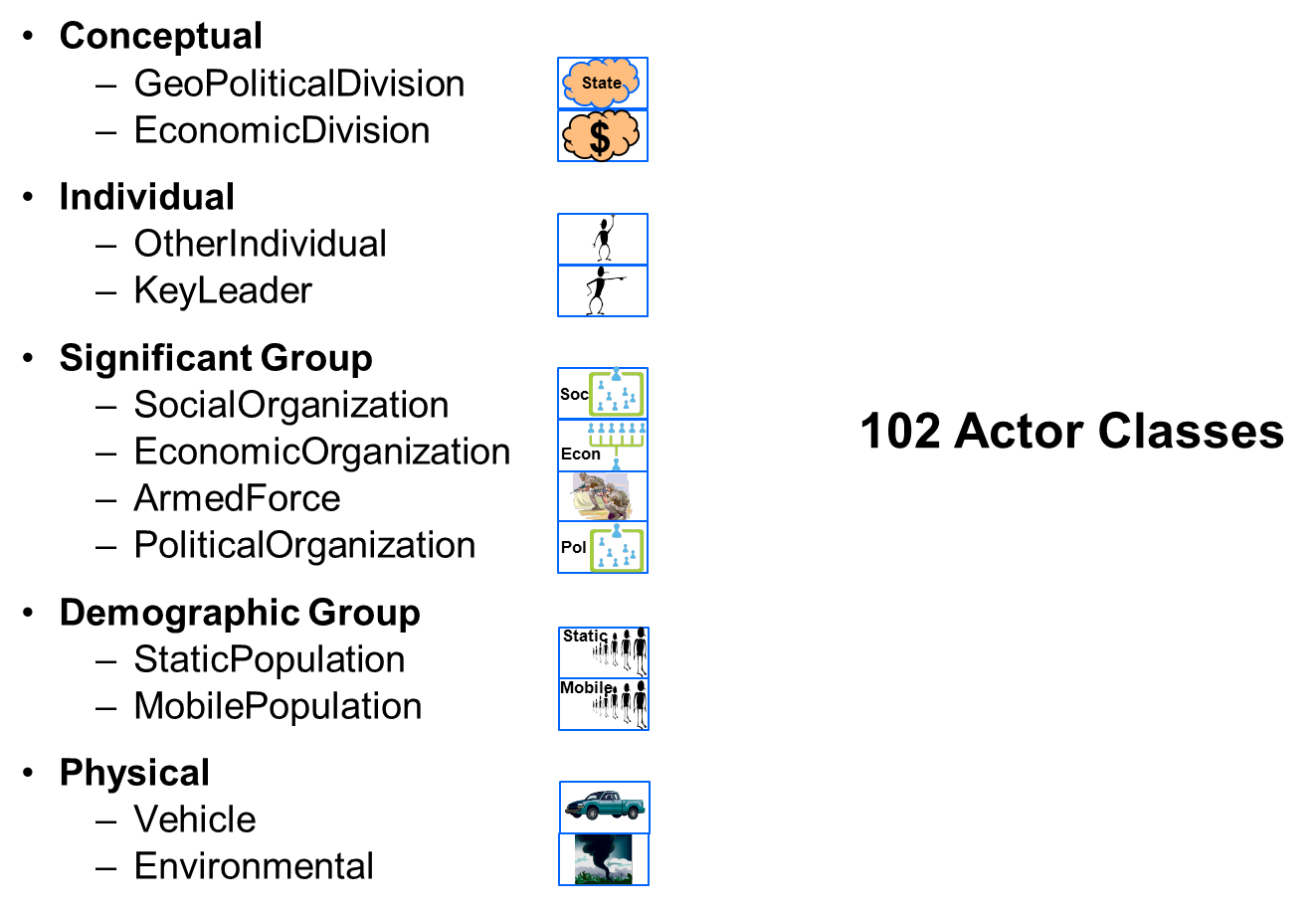 |
3. Action Ontology
|
The figure to the right provides a list of the categories and
subcategories of the action ontology. There are 385 action classes
in the action ontology. A full list of the action classes can be
downloaded here. |
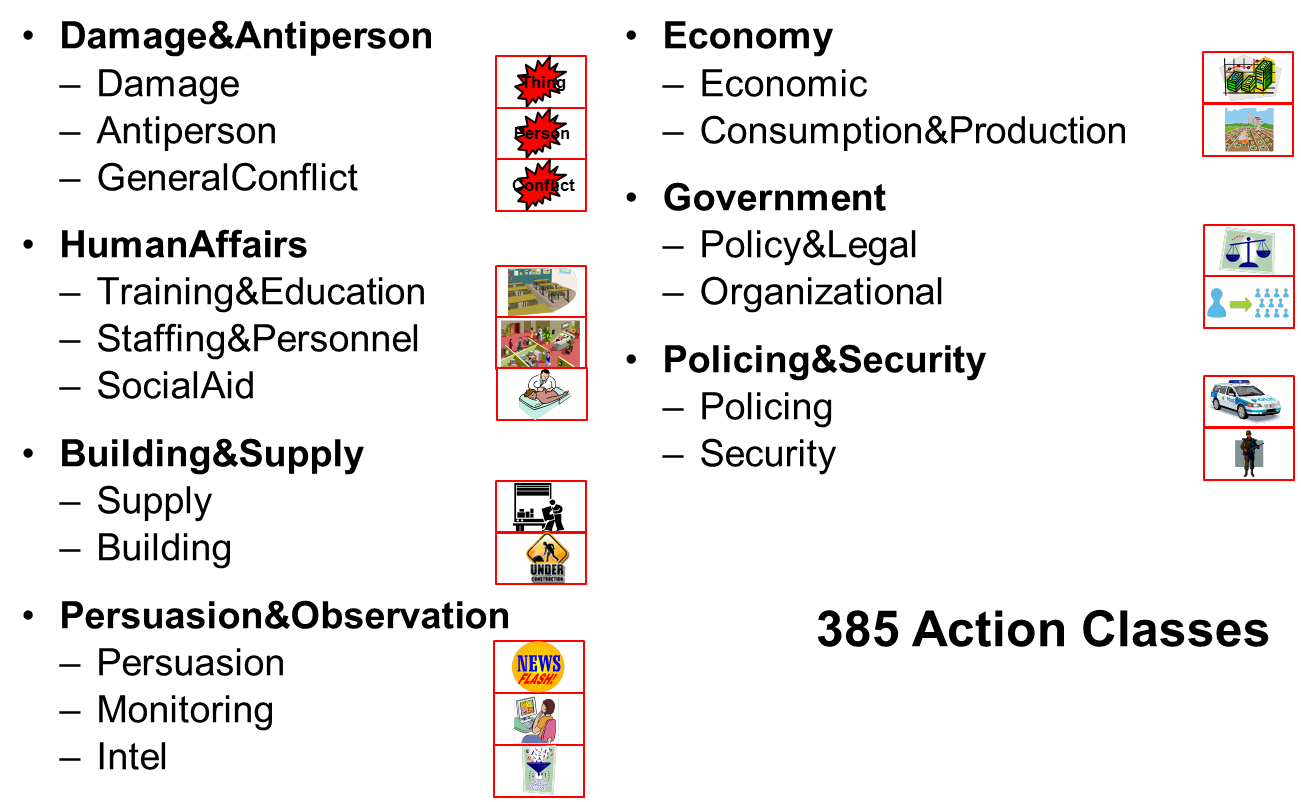 |
4. Environment Ontology
|
The figure to the right provides a list of the categories and
subcategories of the environment ontology. There are 208 environment
classes in the environment ontology. A full list of the environment
classes can be downloaded here. |
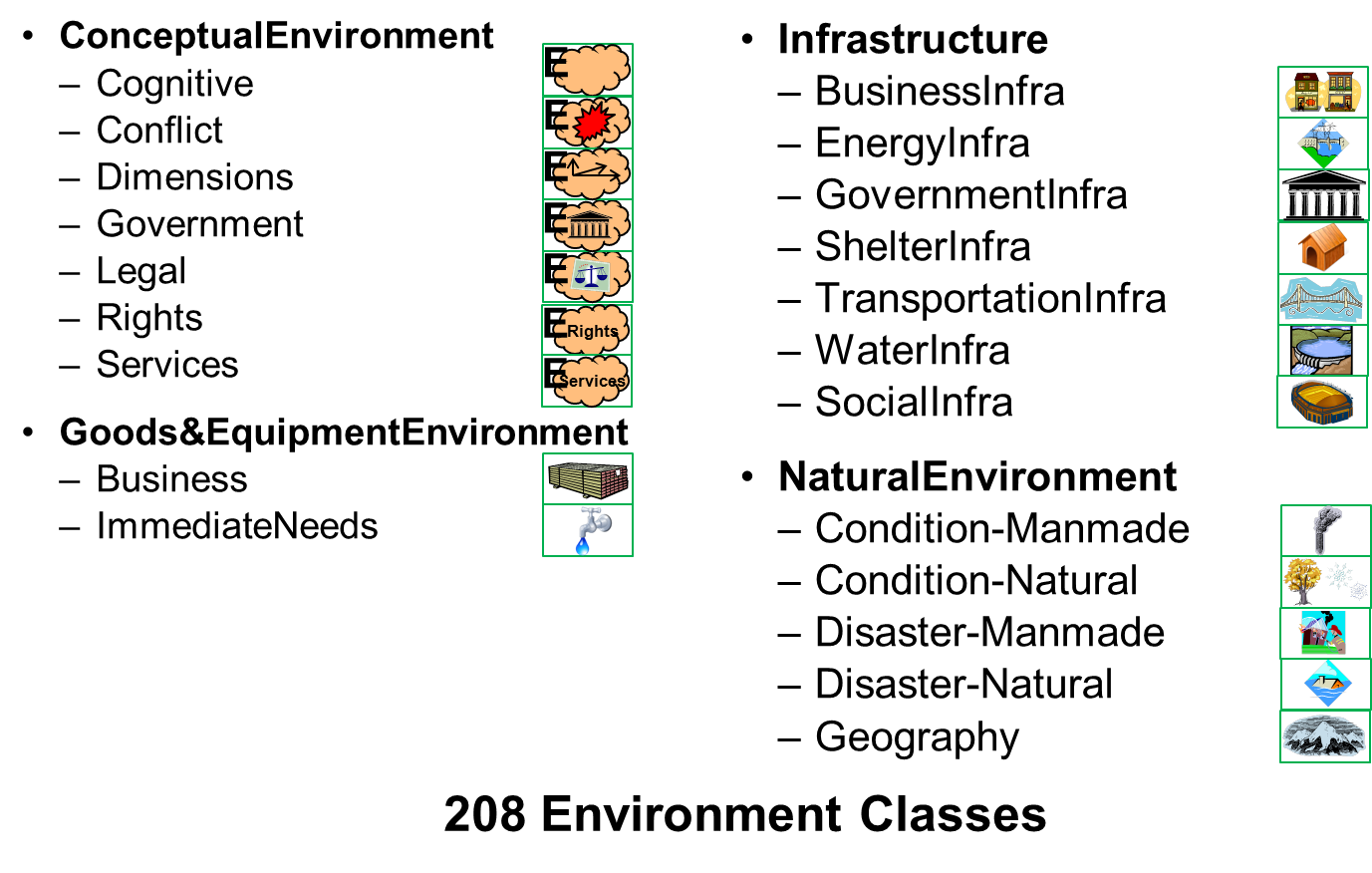 |
5. Connecting the Elements to the Metrics
|
The figure to the right provides a list of the categories and
subcategories of the environment ontology. There are 208 environment
classes in the environment ontology. A full list of the environment
classes can be downloaded
here. |
 |
6. Properties Ontology
Properties are the variables of a class. Each of the element classes
has a property named entityIdentity. Having this property in common
is part of what defines this class. Each instantiation (object) has
a different value of its entityIdentity attribute – its name.
Classes and objects also have behaviors or operations. For example,
some classes represent things that can move – change their location
(another property). For simplicity, operations will be lumped in
with properties.
Subclasses of a class inherit the properties
of a class and add additional properties that help define the
subclass. The figure to the right illustrates this inheritance
process by showing the properties of all elements (including the
existence of a link to one or more metrics) and showing additional
properties of the subclasses down the chains.
The properties
are best defined in terms of the elements. For example, a vehicle
class element clearly must have the property of being capable of
movement. However, the properties actually reside in the element’s
metric. Metrics are also classes and thus can have properties.
This fact permits complex metrics that convey information about
multiple facets of the state of the situation. What this says is
that the figure is useful in defining the properties, but is not
quite correct in displaying the class definitions. The element will
have the identification property and the associated metric(s) will
have that plus all of the other properties. These properties convey
the state information that makes the metrics the state variables.
A full list of the properties ontology can be downloaded
here. |
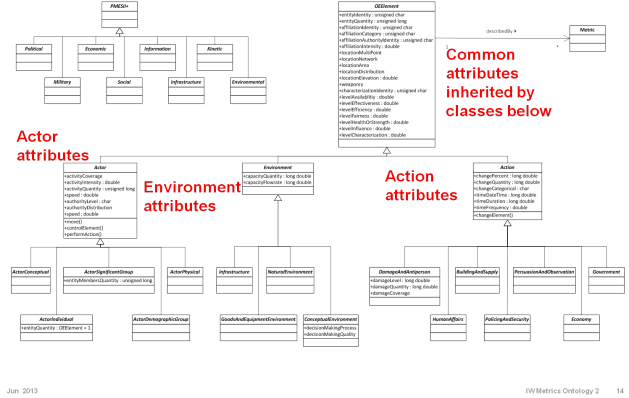 |
Ontology Structures Defined by the Ontology Contents:
The relationships among meanings of the contents of the ontology
define two additional ontology structures: Stocks and Flows and the
Semantic Thesaurus.
1. Stocks and Flows Ontology
|
The figure to the right illustrates a semantic relationship among
the OE elements. A particular environmental element (with an
associated quantity) is present along with actions that increase and
decrease the quantity of the element. The Environment-Oriented
Stocks and Flows structure allows these relationships to be
captured. |
 |
The figure to the right illustrates a more complex set of semantic
relationships. An organization of a given type can be created. The
number of these organizations can be increased or decreased.
There can be other actions that impact the organization or its
members (People). The number of people in the organization can be
increased (directly or by training other people) or decreased.
Certain environmental elements may relate qualities of the
organization or its people. There may be one or more key
people in the organization. There may be an environmental element
that describes the decision making of the key person. The
Organization-Oriented Stocks and Flows structure allows these
relationships to be captured.
A full list of both types of
stocks and flows structures can be downloaded
here. |
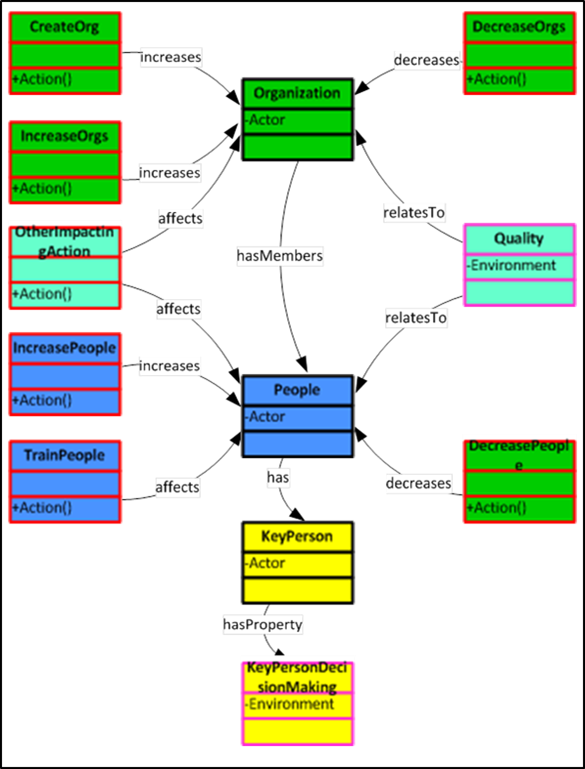 |
2. The Semantic Thesaurus
|
The figure to the right illustrates the way that the intermediate
"semantic terms" form bridges among the metrics. Each metric is
connected to one or more semantic terms and each semantic term is
connected to one or more metrics. Because the OE elements (actors,
actions and environmental elements) are connected to metrics, the
semantic terms also form interconnections among the OE elements. A
full list of the semantic terms can be downloaded
here. |
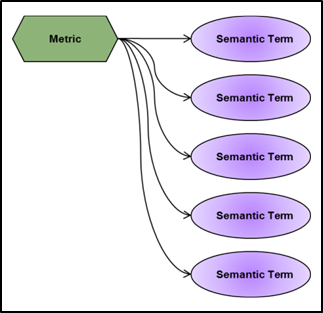 |
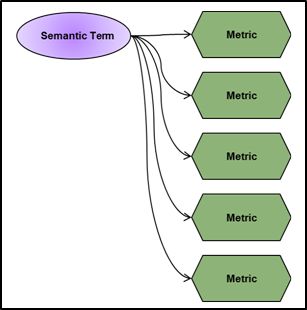 |
Ontology Structures Defined by the Scenario or the Situation:
|
The figure to the right illustrates a typical scenario or situation.
The action takes place within a host nation, with its geography,
resources and populace - and its culture, religions, laws, etc. This
arena is represented by the elipse in the center.
This scenario or situation is an example of irregular warfare
because there are competing actors, each with its own agenda. The
nature of this competition is what causes the situation to be
labeled IW, rather than conventional war or peace.
In this figure, our armed forces are represented as the
Coalition. Our other governmental agencies are represented by the
State Department. Ideally, the goals of these two, while differing
in detail are in consonance. The tasks, however definitely differ
because the capabilities of these actors differ.
The host nation (HN) is also represented by two actors, the HN
government and the HN armed forces. The goals and tasks of
these two actors may differ significantly.
In the typical situation, there are non-governmental
organizations that have significant impacts. Here an international
NGO represents a fairly benign, apolitical actor and a political NGO represents
an actor that sides with one or more of the opposition forces.
Also, typically, there are commercial interests in the arena. Here a
construction company represents contractors hired to implement some
of the tasks of the Coalition and State Department. The acquisition
company represents external interests that wish to purchase HN
resources.
|
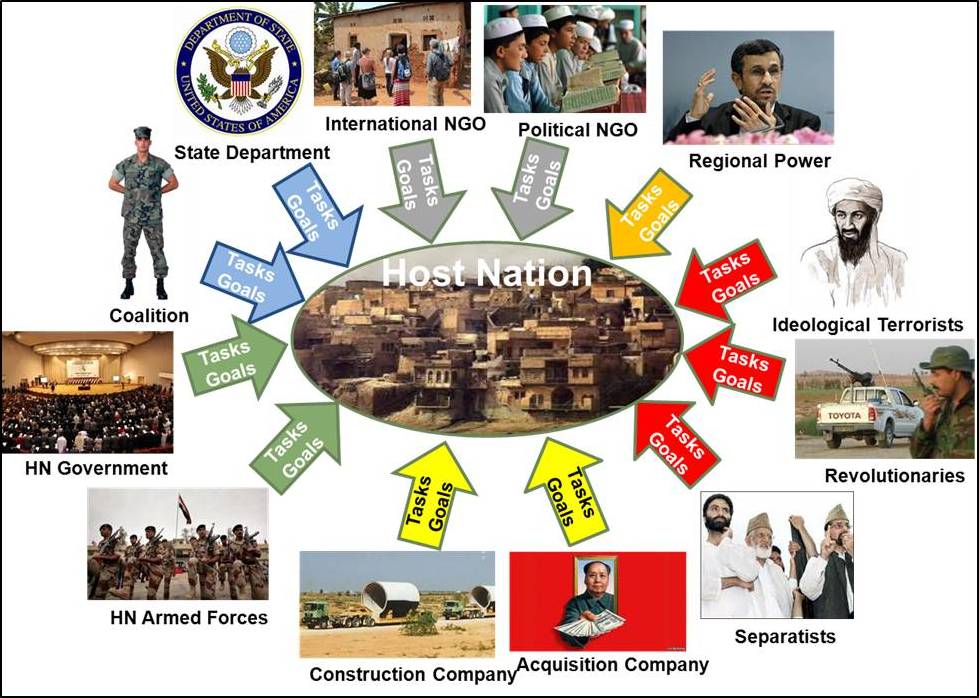 |
The regional power represents some external country in
an analogous position to the State Department, but with possibly
opposing interests.
The three opposing forces that are represented
here consist of groups with interests in opposition to the HN
government. Their goals differ among themselves; however, many of
their actions may be related so that they may form temporary
alliances.
1. The GTO Set Structure
The GTO set structure, illustrated to the right,
formalizes the concept of these competing interests. The
situation or scenario is defined as a model, with a name and a date.
The model has a several GTOSetOwners (the competing actors).
Each GTOSetOwner is identified as an actor within the IW ontology
and has a citation that includes the defining metadata for the GTO
set.
The GTOSetOwner owns several GTOTaskGoalPairs,
consisting of a Goal and a Task for accomplishing the goal.
Each GTOTaskGoalPair has several GTOSubTaskSubGoalPairs, consisting
of SubGoals of the Goal and SubTasks of the Task. Each SubGoal has
one or more Metrics within the IW ontology and each SubTask has
several Actions within the IW ontology.Together, the GTO Sets in
a single model represent a scenario or situation.
|
 |
2. The Actor-Action-Result Set Structure
The Actor-Action-Result (AAR) sets represent a level of detail below
that of the GTO Sets. Where the GTO Sets represent a scenario,
an AAR set represents a vignette within the scenario. An
Action from one GTO set (or perhaps two or three very closely
related Actions) and the associated Metric (or Metrics) are
instantiated and form the basis for an AAR set. For example,
if the Action is attack Bridges and Tunnels, the instantiated action
would be to attack a particular bridge.The action has several
associated elements: time, geo-location, target, and resources
needed for the action. These resources might be physical
elements (vehicles, etc.) and might include other actors.
The action has a result, it affects: the initiating actor,
the resources, the target, and possibly other elements (bystanders,
other infrastructure, etc.).
The rationale for computing the effects is not included.
Rather, the Result placeholder acts as a call for one or more social
or physical theories that provide this rationale.
|
 |
3. The Actor Relation Sets Structure
The Actor Relation Sets provide the final piece of the
description of the scenario or situation. The Actor-Actor and
Actor-Environment structures provide for the definition of the
relationships (boss/employee, leader/follower, tribe/member, etc.)
between actors and the relationships (owner, controller, occupier,
etc.) between an actor and an environmental element.
|
 |
New High-Level Context Diagram:
The original high-level context diagram generates the ontology
structures defined by the OE. Icons for the ontology structures
defined by the ontology contents are added as "internal
relationships" in the new diagram. Icons for the ontology
structures defined by the scenario or the situation are added below
the original diagram as "external (model-specific) relationships.
Together, the icons for these sets of ontologies generate the new
high-level context diagram that serves as an illustration of the IW
Ontology.
|
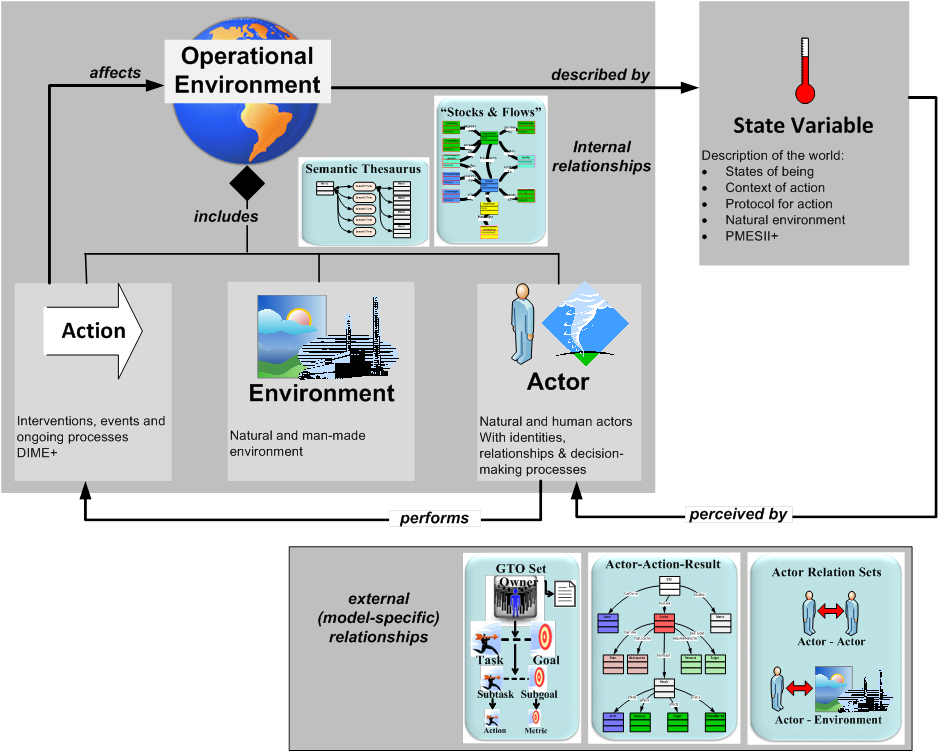 |
Using the Ontology:
Constructing the IW Ontology was not a "science project," with its creation
the sole goal.
It was constructed to be used. Several Use Cases were developed to
illustrate possible uses, two of which have already occurred.
1. Identifying Future Modeling Constructs
TRAC used the list of metrics in the
IW Metrics Ontology, produced in the
previous project, to plan for improvements to the IW TWG. TRAC
personnel reviewed each metric (and its definition) to determine
whether the concept it represented was already included in the
model. Those metrics that were not already included were binned
into three categories: those that should be included in the next
year’s model improvements, those that should be included in future
improvements, and those that were not germane to the model’s
intended uses. The TRAC users passed these results to the IW TWG
modelers. Other model users can employ the new IW Ontology in the
same manner for any existing model in the IW domain.
2. Perform VV&A of Models
Hartley Consulting used the IW Ontology to improve
the categories used in the DIME/PMESII
VV&A Tool for evaluating the static validity of a system’s
conceptual model and coded model. It used this tool in evaluating
the Deployable Exercise Support
system (DEXES II) being built by Dr. Loren Cobb for USSOUTHCOM.
Hartley Consulting will continue to use the ontology in future VV&A
work.
3. Define Model Functionality through GTO Sets
Model users can use the GTO sets produced in this
project, modify them or produce new GTO sets to aid in defining to
modelers the functionality that is needed in a model. The GTO sets
identify a principal actor (in the ontology), the set of actions (in
the ontology) needed to accomplish the desired tasks, and the major
metrics (in the ontology) required to assess accomplishment of the
desired goals. The model users can flesh-out these high-level use
cases with resources and other affected entities (in the ontology).
The resulting set of ontology elements provide the minimal
functionality that the desired model must have.
4. Define Data Needs Using OE Elements
Model users can define the attributes of each OE
element (in the ontology) that is needed in a model. These
attributes in turn define most of the data needs of the model.
5. Define Output Variables Using Metrics
The OE elements in a model are connected to metrics
(in the ontology). The model users can define the output variables
for the model using these metrics. |
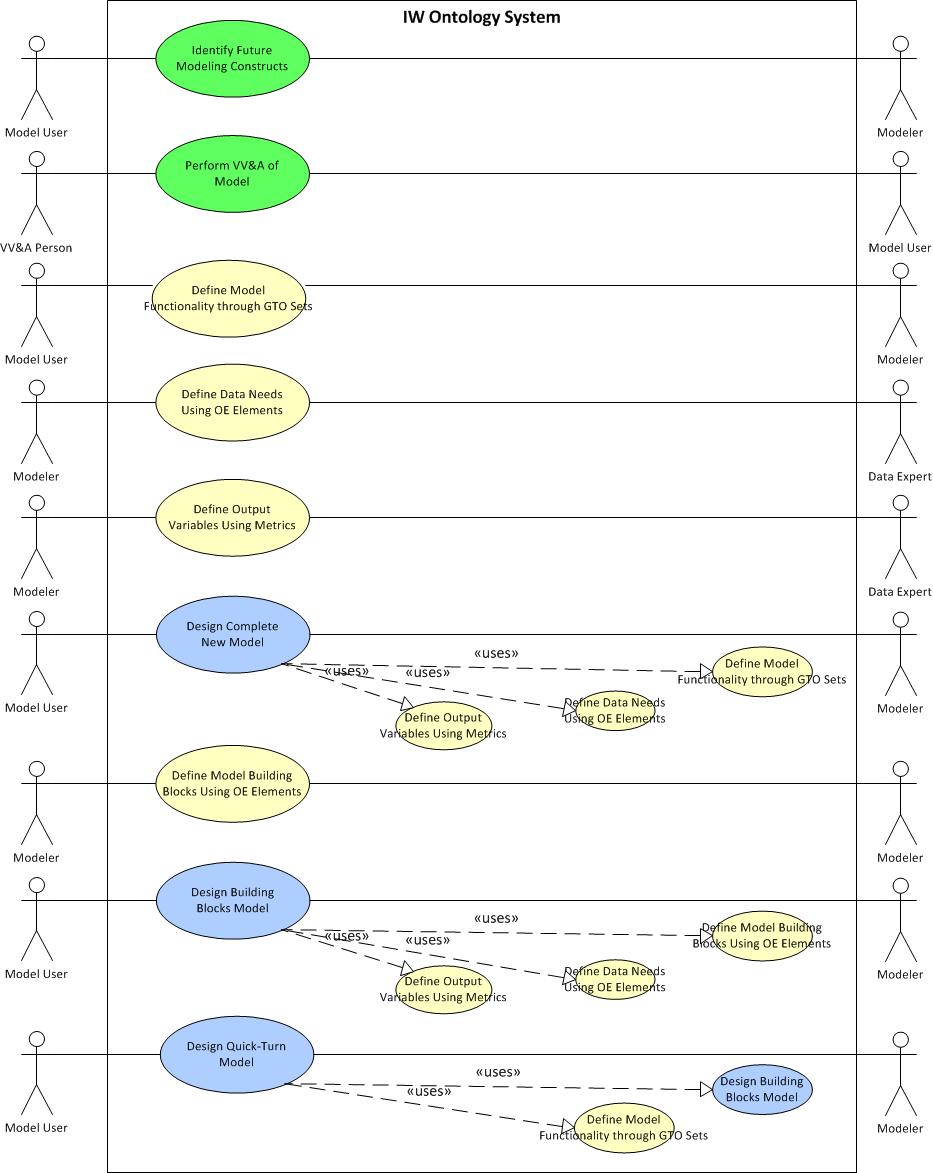 |
6. Define Complete New Model
Model users can use the three use cases: 3. define
model functionality through GTO sets, 4. define data needs using OE
elements, and 5. define output variables using metrics, to perform
a large part of the functional design work for a complete new model.
7. Define Model Building Blocks Using OE Elements
The ontology provides the necessary structure for
creating model building blocks.
7.1 Building blocks model concept
The concept derives from the Lego® blocks
experience. Each kit contains a number of generic block types.
There are several instances of each block type. The user can
combine the blocks to create many different things.
-
Similarities:
the IW building blocks model would contain a number of
standardized, generic modeling objects. The user could combine
the objects to create many different things.
-
Differences:
the IW building blocks model would contain only one copy of each
block type. However, the user would customize each block type
into one or more instances. A modeling infrastructure
would be required to run/use the resulting model.
An IW Building Blocks model would be a coded,
but non-executable model, containing code files for each of the
generic IW concepts and all of the supporting structures (simulation
engine, GUIs, etc.) for an operational model. |
 |
7.2 Building blocks model implementation
First, we start with the high-level context diagram. There are
Actors (defined by nouns that represent active entities) who perform Actions
(defined by verbs). These Actions affect the Operational Environment (OE),
which consists of Actors, Actions and Environment (defined by nouns that
represent passive entities). There are also State Variables (also called
Metrics) that describe the OE elements. Actors perceive the State Variables and
renew the cycle. The OE elements (elements for short) and metrics constitute
the elements of discourse and theoretically comprise a sufficiently complete set
of descriptions / characteristics for many types of IW modeling and analysis.
We use class inheritance to propagate similarities. The
Operational Environment is made up of Elements, which include the Actors,
Actions, and Environment. All Elements have certain properties in common. All
Actors have additional common properties. All Environment elements have common
properties in addition to their Element properties. All Actions have common
properties in addition to their Element properties. Each of the Actor, Action,
and Environment categories is divided into high-level categories and subdivided
into subcategories. Each Element is assigned to one or more subcategories (a
difference between an ontology and a taxonomy). Each Element inherits all of
the properties of its parents. The Metrics are similarly divided into
categories and subcategories and inherit properties from their parents.
A building block modeling strategy requires the following:
-
Coverage:
the ability to define a complete set of building blocks. The high-level
context diagram covers the entire domain. Extensive work on the IW Ontology
has led to assurance of nearly complete coverage at the element and metrics
levels.
-
Granularity: the consistency and appropriate level of granularity. The
elements and metrics of the IW Ontology have fairly consistent granularity.
The elements and metrics are sufficiently detailed that their expansion to
fit a particular model does not require domain research to ensure full
coverage at a finer level of granularity
-
Content:
the ability to create a useful building block. The elements and metrics are
sufficiently detailed so that there is content (properties) which can be
built into objects. The elements and metrics are classes that permit the
creation of instances to fit the needs of a particular model. The
properties are sufficient to begin the process of data requirements
definition. The properties are also sufficient to identify classes of
theories that are needed to implement the methods (the connection to what we
do not know).
8. Design Building Blocks Model
Model users can use the three use cases: 7. define
model building blocks using OE elements, 4. define data needs using
OE elements, and 5. define output variables using metrics, to
perform a large part of the functional design work for a building
blocks model.
A building block modeling strategy also requires the
following:
-
Data and input GUI - The ontology building blocks provide
stubs for the data. The instances refine these stubs.
-
A simulation engine - The ontology building blocks
provide sufficient detail to define the simulation engine
requirements. The instances may entail some refinements.
-
An output GUI - The ontology building blocks provide
sufficient detail to define the output GUI requirements. The
instances may entail some refinements.
-
An analysis engine - The ontology building blocks provide
sufficient detail to define the analysis engine requirements.
The instances may entail some refinements.
The figure to the right illustrates the structure
of the Building Blocks Model. |
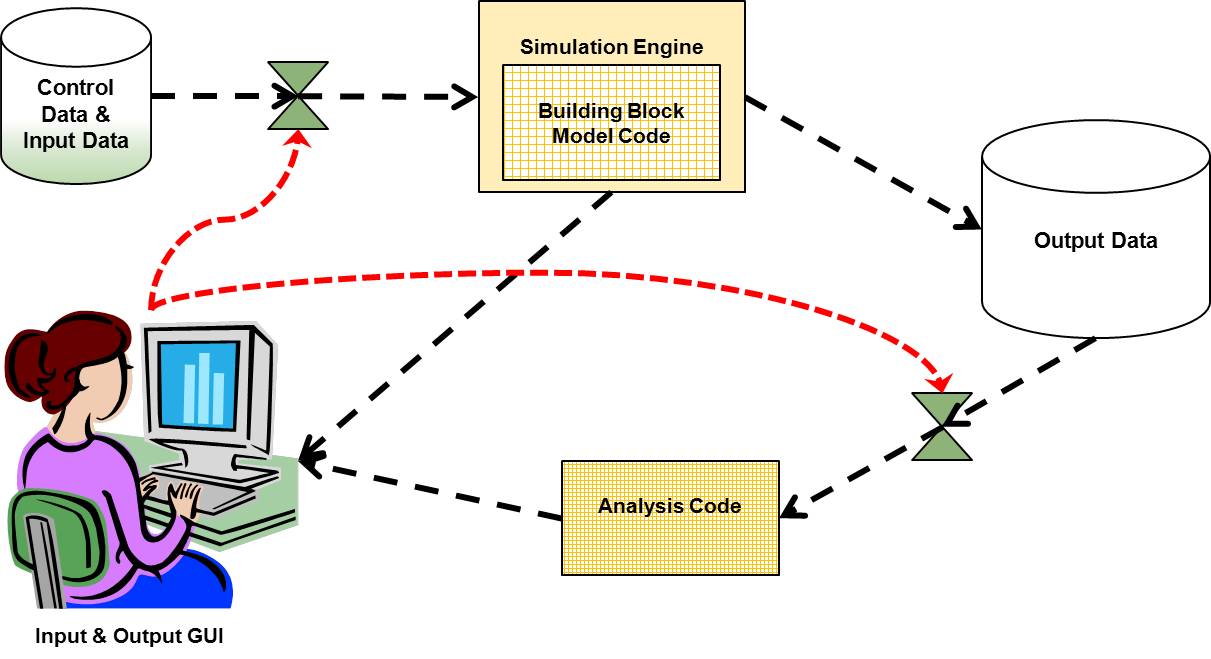 |
9. Design Quick-Turn Model
Model users can use the two use cases: 8. design building
blocks model and 3. define model functionality through GTO sets, to design a
quick-turn model.
The concept is to create new models quickly to answer new
questions. “Quickly” implies simple models; however, in the IW domain we do not
know enough to do “simple.” The solution is to start with something that can be
customized to meet the new needs. Thus, quick-turn modeling in the IW domain is
the process of creating new simulations models quickly, with each new model
fitting a particular analytic need, and each new model starting from the IW
Building Blocks Model.
A building block modeling strategy supports quick-turn
modeling. Each quick-turn model is a variant of the building blocks model. A
quick-turn model involves a scenario or vignette.
-
The first pass at defining the scenario or vignette requires
defining the principal players – owners, defining the tasks and goals for
each owner, and results in a set of Goal, Task, Owner (GTO) sets.
-
The second pass requires selecting the elements and metrics
that correspond to the GTO sets. Each GTO set consists of an owner, a set
of Task/Goal pairs, and sets of SubTask/SubGoal pairs for each Task/Goal
pair.
-
Unwanted GTO sets are removed.
-
Unwanted Task/Goal pairs are removed.
-
Unwanted SubTask/SubGoal pairs are removed.
-
The third pass requires defining the actor-action-result
diagrams that will implement the GTO sets, defining resources, targets,
times, places, and other affected elements, selecting the elements that
correspond to these, defining the appropriate metrics, and defining the
theoretical bases for evaluating the results. In this pass, semantically
related elements may also be added. The Stocks and Flows relations are
relationships that will be helpful in determining other elements that need
to be included. The Semantic Thesaurus relations may also be helpful. This
process is one of adding in additional ontology elements.
-
The fourth pass requires creating instances from the
building blocks:
-
actor instances – specific examples to fit the scenario,
with additional attributes and specific methods,
-
environment instances – specific examples to fit the
scenario, with additional attributes, and
-
action instances – specific examples to fit the
scenario, with additional attributes and specific methods based on the
theories chosen.
|
After the scenario has been defined, the model can
be created. The figure to the right illustrates the processes for
creating a quick-turn model:
-
Code the
building block model;
-
Create instance
objects for the actors, actions, environment elements, and
metrics;
-
Create the
detailed methods, based on appropriately selected theories;
-
Select and edit
the input data;
-
Refine the
analysis code; and
-
Code the
quick-turn model.
|
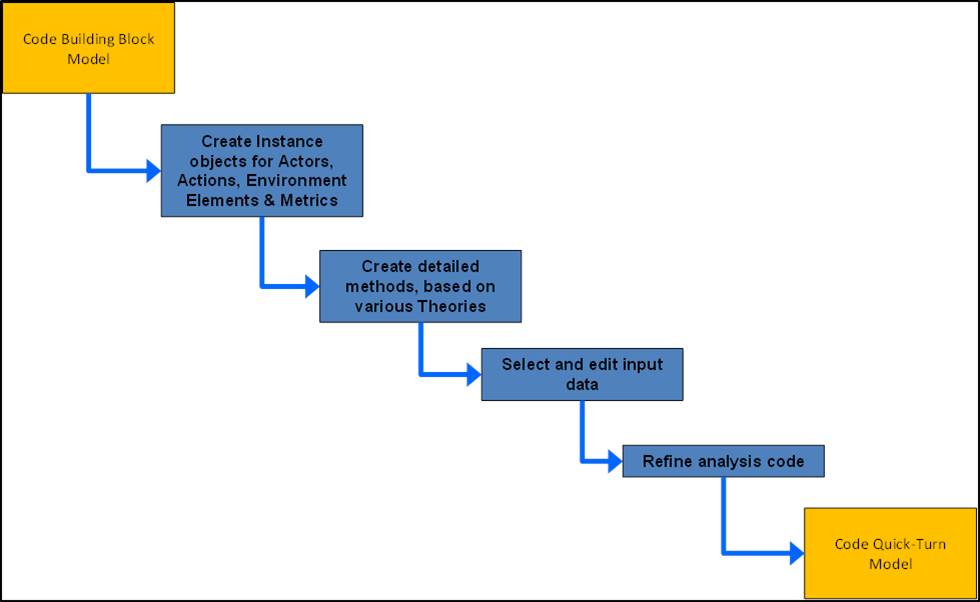 |
|
A building block modeling strategy supports
quick-turn modeling. Implementation requires coding the instances,
creating the logic for executing the actor-action-result diagrams,
modeling V&V during the creation phase, collecting data, and data
V&V. Execution requires executing the model, analyzing the results,
and the supporting infrastructure to perform these actions.
The figure to the right illustrates the structure of
a quick-turn model. The figure parallels that of the building
blocks model structure shown in earlier. The main differences are
in the conversion of the building block model code to quick-turn
model code and the refinement of the analysis code. The quick-turn
figure also shows that the databases are filled, indicating actual
use of the simulation. |
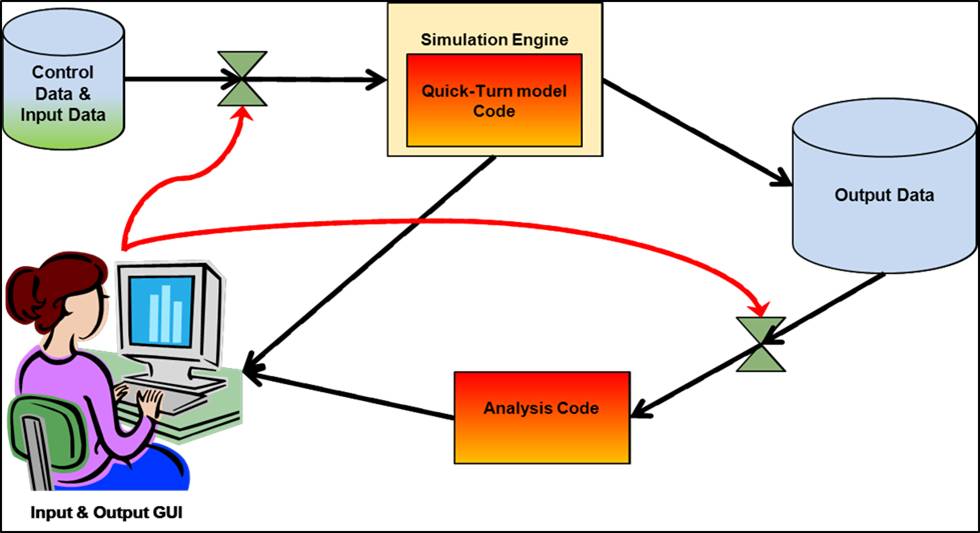 |
Expressing the Ontology:
An IW ontology can be stored (expressed) in a database and
encoded (expressed) into a formal OWL ontology with some limitations.
We defined an ontology as an “explicit specification of a
conceptualization.” In the prior project, we used
one OWL language to express the explicit specification. We have done the same
in this project. However, we have found that the IW Ontology has a richer
conceptualization than can be entirely expressed in the OWL-DL or OWL Lite
languages.
We had a problem of relating the element classes (Actors,
Actions and Environment) to the Metric classes. We found a work-around in
describing the Metric classes as Metric properties, which can be related
to classes in OWL. However, we also describe several other relations that exist
in the conceptualization of the IW Ontology, which cannot be expressed in OWL-DL
/ OWL Lite.
|
The ontology schema, that is the definition of the
relationships among the ontology elements, is encoded in the OWL
files. Because of OWL’s centrality in ontology expression, there
are third party tools that permit viewing and manipulating the
ontology, such as Protégé. One of the purposes of OWL is to provide
inferencing, which requires that any inference be “decidable” by
reasoning software. This restriction also restricts what can be
expressed in the language. The entire IW Ontology can be expressed
in an Access database. However, the schema in Access is implicit
and is encoded in numerous queries contained in the database. |
 |
|
Discerning the entire schema is not trivial and
requires additional coding within the database. There is no third
party software that addresses the contents of an Access database as
an ontology. Thus, viewing and manipulating the ontology must be
done with user-defined queries within the database. Decidability is
not enforced. Queries designed for inferencing must be created by
the user and will yield results that depend on the user’s skill and
knowledge of the schema. The upper table to the right captures
these differences.
The lower table to the right captures the major
differences in what we know from the IW Ontology conceptualization
and what we can express in the two candidate explicit
specifications. The differences lead to our recommendation for
building an Access GUI tool.
|
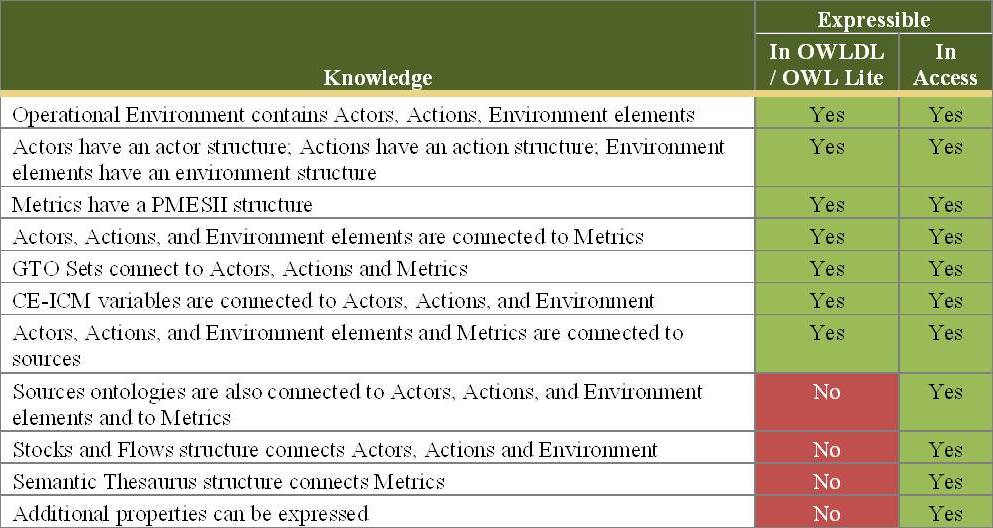 |
Conclusions:
The first two conclusions derive from this project’s
process: building on prior efforts and using collaborative methods. The
third conclusion relates the general value of an ontology in understanding
its domain to the value for this particular domain, the IW domain. The
fourth conclusion relates to technical issues that arose in the course of
the project. The fifth conclusion relates to the benefits that the ontology
provides in creating applications for the ontology. The sixth conclusion
provides some caveats concerning the IW ontology.
This project, like most other projects, rests on prior
work. In this case, the prior metrics ontology served as an excellent
starting point for identifying environmental properties. The prior project
concentrated on building a metrics ontology for IW; however, it included the
High-level Context Diagram. This diagram was the key concept in expanding
the IW ontology into a unified specification of the entire IW domain.
Some parts of ontology creation are essentially solitary
acts. These parts require concentration on converting an initial concept
into a set of consistent parts. However, other parts of ontology creation
require collaboration. These parts require the inclusion of new ideas and
the testing and checking the implementation for errors. This project and
the prior one have shown that an IW ontology can be built in a collaborative
manner using a series of workshops.
The IW domain is such a large domain that understanding it
as a whole is quite difficult. Part of the value of an ontology is that it
aids in understanding the domain. The IW ontology can be viewed as
Operational Environment concepts (including Actors, Actions, and the
Environment) that are described by properties (metrics). In addition, there
are numerous semantic relations among the concepts that help in describing
the IW ontology. These structural specifications help in understanding the
IW domain that the ontology specifies.
An IW ontology can be stored (expressed) in a database and
encoded (expressed) into a formal OWL ontology with some limitations.
An IW ontology can be used for a variety of applications.
Two of the use cases have already been implemented, with proven value.
However, the major benefit from the IW Ontology lies in the conceptual
domain: it defines – explicitly – our current understanding of the
entities, processes and metrics of IW. Because of this, it can support many
applications.
The modeling process provides an example of this point. A
model is an abstraction of reality – that is, it includes salient parts of
reality and leaves out the unimportant parts. Naturally, what is
salient and what is unimportant depends on the intended use of the model;
however, to make this distinction, one must know what the parts are. In
some domains, we have a long history of modeling and confidence in our
knowledge of the domain. This is not the case in the IW domain.
However, the IW Ontology:
-
Partitions the
Operational Environment into manageable pieces;
-
Untangles the
possibilities into meaningful elements
-
Organizes the
elements in logical ways
-
there are actors
of various subtypes;
-
there are actions
of various subtypes;
-
there are
(passive) environmental elements of various subtypes; and
-
there are state
variables (metrics) of various subtypes;
-
Provides various
semantic linkages among the elements;
-
Separates what we do
know from what we do not know;
-
Identifies where what
we do not know (theories) connects to what we do know (the elements and
their structures); and
-
Is very nearly
complete and comprehensive.
We now have a list of the parts of the IW domain. We have a
description of the various types of relationships among the parts. We have
a structure for describing the human goals and tasks (the GTO sets) that
drive the changes within the IW domain. Moreover, we have the connections
of this structure to the parts of the IW domain. Perhaps most importantly,
this structure points to where what we know interacts with what we do not
know – the science behind calculating results. The IW Ontology provides all
of this. A modeler can use the IW Ontology to begin the abstraction
process.
The IW ontology is “nearly” complete and comprehensive.
First, this means that there may be a few elements that still need to be
identified that belong in the ontology and that are of comparable
granularity to the existing elements. Second, the phrase “at this level of
granularity” is assumed, but not explicitly stated. That means, for
example, that the mental states of a decision maker are not included in this
ontology. That would require an ontology with a finer granularity.
The partitions of the IW ontology are rational and useful,
but not “correct” in any absolute sense. As an analogy, consider a
chocolate bar. One could divide it into 12 equal size pieces in several
ways, each yielding the same amount of chocolate in each piece. If the bar
is rectangular, but not square, one could produce 12 long, skinny pieces by
cutting parallel to a long side or 12 shorter, somewhat fatter pieces by
cutting parallel to a short side. One might also make three cuts parallel
to the short side and two cuts parallel to the long side, producing 12
short, fat pieces. If the chocolate bar were pre-marked in this last
fashion, one would say this is a “rational” division because it fits some of
the observed characteristics of the chocolate bar. The shape of the pieces
from each cutting choice might determine how “useful” the division process
is. Notice, the division into 12 pieces as opposed to 48 or 20 is a
“granularity” choice, which has to do with usefulness.
The IW ontology “supports” modeling, data definition, data
interchange, model interoperability, theory choices, VV&A, and other
valuable applications. However, it does not guarantee that these things
will be done properly.
Recommendations:
The recommendations fall into four groups: a definition for the
Option Period specified in the PWS [TRAC 2012], expansion of the Use Cases
defined earlier, creation of a new type of IW model, identification of use
cases, and additional ontology work.
We would use the following design:
-
The underlying ontology
content is contained in an Access database, rather than being expressed in
the OWL language. The rationale is that the database can express all the
knowledge we have concerning the ontology.
-
The GUI itself will be
implemented as queries and menus within the Access database.
-
Make the schema for the
database more accessible to the user.
-
Produce reports that
describe the various parts of the ontology.
-
Insert additional
elements into the ontology.
-
Create new GTO Sets for
new scenarios.
-
Use the GUI to create a
restricted ontology using the GTO Sets, Stocks and Flows and the
Semantic Thesaurus and define the resulting data needs and output
variables.
-
The Task structure will
include the following elements:
-
A draft design document,
-
A draft functioning
version of the GUI,
-
Draft user and design
documentation,
-
A final functioning
version of the GUI,
-
Final user and design
documentation,
-
Up to three workshops to
support the design and review of the GUI,
-
Notes on the workshop
results, and
-
Attendance at some
professional meeting to present the work and execute associated
networking research.
Using the GUI that would be created, we could actually create
these models.
Our third recommendation is to further amplify the use case
descriptions and consider additional use cases. A formal set of use cases would
be useful to support implementation decisions. The Use Cases described above
represent some of the possible applications of the IW Ontology. There may be
others that are of interest to the U.S. Government. Because the descriptions
are only sketches of the applications, amplification of their descriptions would
aid in decision-making.
Our fourth recommendation is to consider potential additional
ontology projects.
Refining the
Ontology
During the process of creating an IW model, whether as part of
the Building Blocks Model / Quick-Turn Model process or as part of some other
model creation process, it is likely that the need for additional OE elements or
metrics might be discerned. These additional elements or metrics would be
integrated into the ontology.
Additional
Ontologies
The IW Ontology describes the IW domain at a particular level of
granularity. Models that require a finer level of granularity would require
additional ontologies. For example, models of the decision making process might
require an ontology that includes the mental states of the decision maker, with
correspondingly finer actions and metrics.
If you arrived here using a keyword shortcut, you may use your
browser's "back" key to return to the keyword
distribution page.
 Return to Hartley's Projects Page
Return to Hartley's Projects Page























